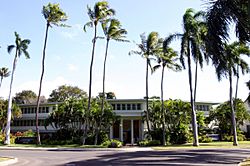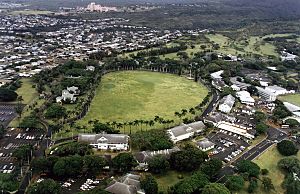Fort Shafter facts for kids
Quick facts for kids Fort Shafter |
|
|---|---|
| Honolulu, Hawaii | |

Richardson Hall at Fort Shafter, nicknamed the "Pineapple Pentagon"
|
|
| Coordinates | 21°20′42″N 157°53′02″W / 21.345°N 157.884°W |
| Type | Army post |
| Site information | |
| Controlled by | U.S. Army |
| Site history | |
| Built | 1905-1907 |
| In use | 1907 – present |
| Battles/wars | Attack on Pearl Harbor |
| Garrison information | |
| Current commander |
General Charles A. Flynn |
| Past commanders |
General Vincent Brooks |
| Garrison | U.S. Army Pacific |
Fort Shafter is a special area in Honolulu, Hawai‘i. It's the main office for the United States Army Pacific. This group leads most U.S. Army forces in the Asia-Pacific region, except for Korea.
Fort Shafter is built on a ridge between the Kalihi and Moanalua valleys. It also spreads onto the flat land near the coast, known as Shafter Flats. A part of Fort Shafter is called the Palm Circle Historic District. This area is listed as a very important historical place in the U.S. It's also known simply as Palm Circle.
Contents
A Look Back: Fort Shafter's History
Fort Shafter is the oldest military base on the island of Oahu. It celebrated its 100th birthday on June 22, 2007.
How Fort Shafter Started
For a century, Fort Shafter has been the main Army headquarters in Hawaii. Building started in 1905 on land called Kahauiki. This land used to belong to the Hawaiian kingdom and was later given to the United States government.
When the base opened in 1907, it was named after Major General William Rufus Shafter. He was a military leader who led a U.S. expedition to Cuba in 1898.
Palm Circle: The Heart of the Fort
Palm Circle was designed as a living area for a group of soldiers. The buildings where soldiers and officers lived were placed around a parade field. This field was surrounded by tall royal palm trees. The first group of soldiers to live at the new base was the 2nd Battalion of the 20th Infantry Regiment.
Over time, Fort Shafter grew bigger than just Palm Circle. Tripler Hospital used to be where a highway intersection is today. The hospital moved to its current spot in 1948. In 1914, a larger living area for soldiers was built. A place for military supplies, called the Hawaiian Ordnance Depot, was added in 1917. In 1921, the main Army office in Hawaii moved to Fort Shafter from downtown Honolulu. Finally, in 1940, a new area was built for groups that handled military communications.
Fort Shafter During World War II
War came to Fort Shafter on December 7, 1941, during the Attack on Pearl Harbor. The Hawaiian Department commander, Lieutenant General Walter C. Short, was at Quarters 5. Sadly, one soldier, Corporal Arthur A. Favreau, was killed on base by a stray Navy shell.
Fort Shafter became a very busy headquarters. The soldier living areas on Palm Circle were changed into offices. The main headquarters had different names during the war, like U.S. Army Forces, Central Pacific Area. In 1944, the Army Corps of Engineers quickly built three buildings, nicknamed the "Pineapple Pentagon," in just 49 days. Two large fishponds were filled in to create the flat land known as Shafter Flats.
Fort Shafter After the War
For most of the time since Second World War, Fort Shafter has remained the main Army headquarters for the Asia-Pacific region. In 1947, the headquarters was renamed U.S. Army, Pacific.
The base kept changing to meet the Army's needs. In the early 1960s, a new highway, the Moanalua Freeway, split the base in two. In 1974, Fort Shafter became home to U.S. Army Support Command, Hawaii. It also housed the U.S. Army Corps of Engineers, Pacific Ocean Division. In 1979, the Army created U.S. Army Western Command, which was renamed U.S. Army, Pacific in 1990.
In 1983, the Army gave about 750 acres (3 km2) of undeveloped land on the north end of the base to the State of Hawaii. Today, Fort Shafter is still very important for leading and supporting Army forces in the Asia-Pacific region. It even has an underground command center beneath Palm Circle.


